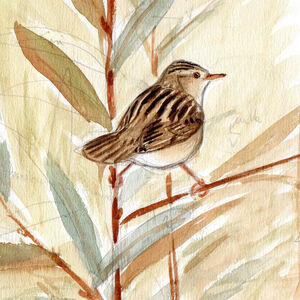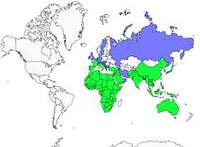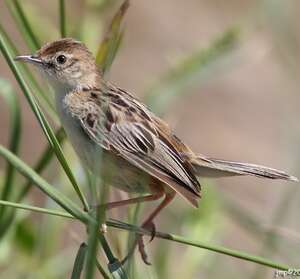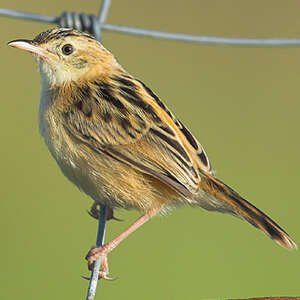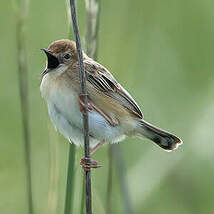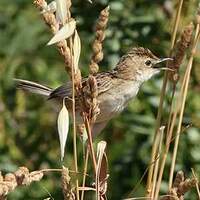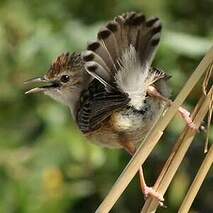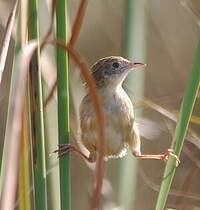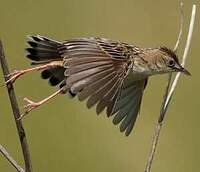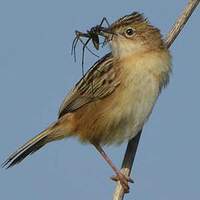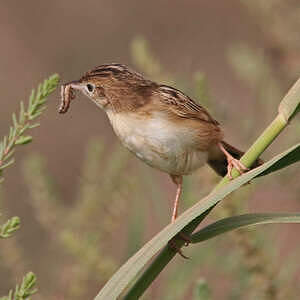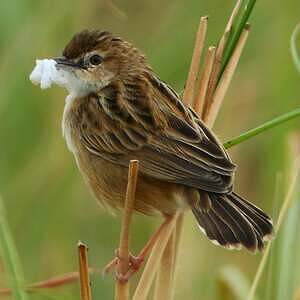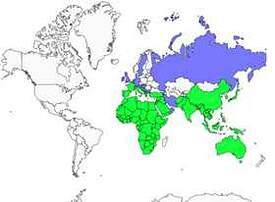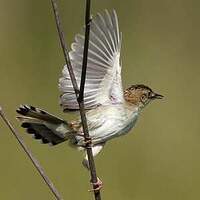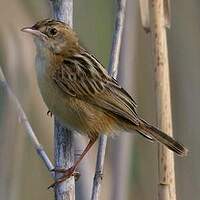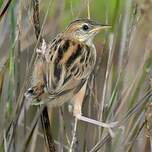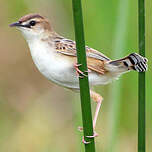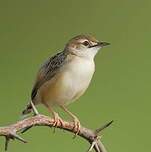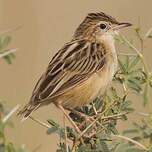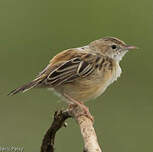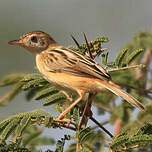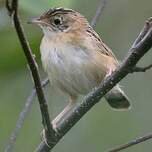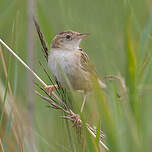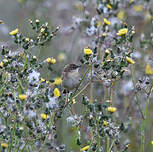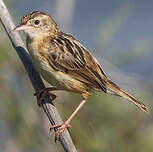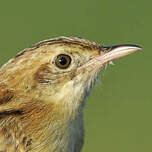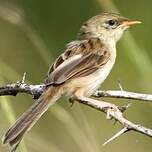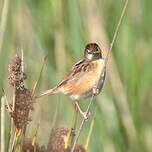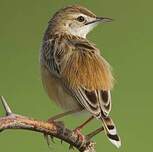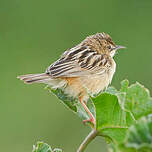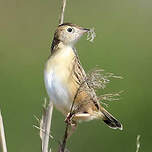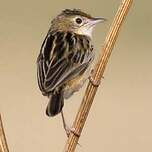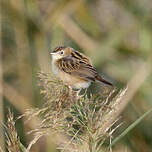Zitting Cisticola
Cisticola juncidis - Cisticole des joncs
Identification
The Zitting Cisticola is the only representative of the Cisticolidae family in Europe. Representatives of the genus Cisticola have a particular shape, a compact body held by strong legs, small wings, a strong, often slightly curved beak, and a stepped and mobile tail, often black and white at the tip.
The Zitting Cisticola fits into this scheme. It is a small cisticola of barely more than 10 cm long. 17 subspecies are described, all in the Old World and still 2 in France, but these subspecies differ very little from each other. Here we will describe this cisticola as it is seen in our country.
There is no sexual dimorphism. When this cisticola is seen, usually furtively, it gives the impression of a small reddish bird. The upper parts (cap, mantle, back, wing covers and above the tail) appear reddish brown with strong blackish streaks. In fact, it is the feathers that are blackish, but widely edged with reddish brown, giving the opposite impression. The nape, the back of the cheeks and the rump are without streaks. The remiges and retrices, except the central ones, are blackish brown, the first finely lined with reddish brown, the second widely. The central retrices are the same colour as the mantle and the other ones show an enlarged blackish subterminal zone and a white end. This pattern is clear and well visible only when viewed from below (see photos). The honey eye is well visible in the middle of a cream white area formed by the eyebrow, the laurel and the front of the cheek. The beak is long, pink with blackish curved culmen.
The throat, the lower chest and the belly are cream white. The upper chest is clearly shaded with brown. The flanks, the breeches and the undersides of the tail are the reddest parts. The legs are pink.The juvenile resembles the adult, but when leaving the nest, it can be recognized by its yellow lower bill, its dark brown iris, its blacker streaks in its mantle and its pale pink legs.
Subspecific information 17 subspecies
- Cisticola juncidis juncidis (s France to Turkey and Syria, also Egypt and large Mediterranean islands)
- Cisticola juncidis cisticola (w France, Iberian Pen., Balearic Is. and nw Africa)
- Cisticola juncidis uropygialis (Senegal and Gambia to Ethiopia, Rwanda, Tanzania and Nigeria)
- Cisticola juncidis terrestris (Gabon and Congo to s Tanzania and south to South Africa)
- Cisticola juncidis neuroticus (Cyprus, Lebanon and Israel to w Iran)
- Cisticola juncidis cursitans (e Afghanistan to n Myanmar and s China and south to se India and dry lowlands of Sri Lanka)
- Cisticola juncidis salimalii (sw India)
- Cisticola juncidis omalurus (Sri Lanka. except dry lowlands.)
- Cisticola juncidis brunniceps (s Korea, Japan and Batan I.. n Philippines.)
- Cisticola juncidis tinnabulans (se China and Taiwan to Thailand, Indochina and the Philippines. except Batan I. and the Palawan Is..)
- Cisticola juncidis nigrostriatus (Palawan Is.)
- Cisticola juncidis malaya (Nicobar Is., se Myanmar, sw Thailand, the Malay Pen. and the Greater Sundas)
- Cisticola juncidis fuscicapilla (e Java, the Kangean Is. and lesser Sundas)
- Cisticola juncidis constans (Sulawesi and nearby islands)
- Cisticola juncidis leanyeri (nc Australia)
- Cisticola juncidis normani (nw Queensland n to ne Australia.)
- Cisticola juncidis laveryi (ne Australia, sc New Guinea)
Foreign names
- Cisticole des joncs,
- Cistícola buitrón,
- fuinha-dos-juncos,
- Zistensänger,
- szuharbújó,
- Graszanger,
- Beccamoschino,
- grässångare,
- Cistussanger,
- cistovník ryšavý,
- cistovník rákosníkový,
- Cistussanger,
- heinäkerttu,
- Landeryklopkloppie,
- trist,
- Hálmsöngvari,
- chwastówka (zwyczajna),
- zāļu platastīte,
- brškinka,
- Веерохвостая цистикола,
- Cici padi,
- セッカ,
- 棕扇尾莺,
- นกยอดข้าวหางแพนลาย,
- 棕扇尾鶯,
Voice song and call
The male Zitting Cisticola sings a very rhythmic, undulating, circular flight pattern high above its territory. Each wave contains a single syllable of its song, which is a distinct, high-pitched and metallic psit. Its song, psit psit psit psit... is recognisable and unmistakable.
The alarm call is a repeated tchep tchep tchep... or a more metallic tsip. Other close calls are contact calls.
Habitat
Zitting Cisticola live in open grasslands with tall grass, abandoned wastelands, and the edges of agricultural land. They often live within or close to wetlands such as marshes, flooded areas, waterlogged meadows, ditches along roads, and marsh edges. They can also be found on salty coastlines with seablite, in intertidal zones, and rice fields. These birds usually live at low altitudes, but have been found at altitudes of up to 2100 meters in India.
Behaviour character trait
Zitting Cisticolas live alone or in pairs, but outside the breeding season they also gather in loose flocks.
They are not particularly shy, but they are rather difficult to observe as they have the habit of staying on the ground in tall grass. Very careful during the breeding season, the males typically perch out in the open on tall stems, the top of bushes or telephone wires to sing. Their song flight begins with a wavy trajectory from a perch, their singing starting at the same time. Each bound they make into the air with their tail spread is synchronized with a single note. Climbing up to 15 to 30 meters they can cover a fair distance before usually returning to their original perch. When disturbed, Zitting Cisticolas are reluctant to burst out of cover. Usually they make a short, low flight before diving into the grass. They move like a mouse, crawling through tall vegetation and remaining motionless if they feel threatened. Their flight is characteristic, short but active with their wings buzzing and tails spread. This hyperactive bird, never at rest to the point of appearing almost neurotic, always seems to have something to do, except when disturbed.Dietfeeding habits
The Zitting Cisticola is insectivorous but it does not disdain the small seeds of the aquatic plants either. When it moves in the reeds, it assiduously looks for spiders and, obviously, it never appropriates a spider's web for making its nest without devouring its owner. The insects are captured in the vegetation, on the ground, but rarely in the air.
Reproduction nesting
Birds begin preparing to nest in the first two weeks of March. The males tirelessly patrol their small territory and suddenly swoop down onto a place they consider close to the female's perch. They pursue her with swift, zigzagging flight between the reeds and shrubs. The males start building a characteristic and elaborate nest by assembling and intertwining herbs, marsh plants and other grasses to form a support about 30 to 40 cm above the ground. The herbs are intertwined with threads from spider cocoons. Because spider webs are very adhesive, the birds quickly make a strong structure, which the female and sometimes the male complete with plant fibers.
In the very thick bottom, the birds deposit pieces of dry grass. On this layer of vegetation, they add a second layer made of phragmites flowers or willow down. Once finished, the nest has the shape of an oval flask or bottle, with a very wide bottom. It is of a very modest size, no more than 15 cm in height and 6 cm in width.The first nests seen in March or April are built at the top of the growing vegetation, totally concealing them. Nobody would think then that this whitish mass could be a bird nest. The entrance is located at the upper part of the nest, slightly to the side and on a slightly sloping plane, so that wind and rain do not cause any damage inside. Nest building takes between 8 and 10 days. The first clutch starts at the end of March but sometimes only in April, as the chicks are very sensitive to the cold and humidity still present at that time.She lays 4-5 eggs of variable colour, white, pale pink, greenish or azure with a very fragile shell. The following lays contain only three eggs. The female lays one egg per day until the clutch is complete. She incubates alone but her partner stays nearby. 12 days after the last egg is laid, the chicks hatch. Both parents feed them with insects and spiders. After 9-10 days, they put their heads out of the opening to demand their food. They leave the nest at 13 days but they are not able to fly until 16 days, though still with difficulty. They hide in nearby grass and scamper like mice while they wait for their food. Three clutches occur in one season, the first in April, the second in June and the third in August, almost always at the end of the month. For this last one, Zitting Cisticolas use the nest of the two previous clutches.
Geographic range
The Zitting Cisticola is present on three continents: Europe, Africa and Asia, but in very limited areas. In Europe, it can mainly be observed in France, in the Iberian Peninsula, in Italy and in Greece. In Africa, it is present in the Maghreb, and almost everywhere south of the Sahara, except in arid zones. In Asia, we only find it in the south-east, from Pakistan and the Indian subcontinent to the Philippines and Indonesia. Almost everywhere, it is sedentary. 18 subspecies populate the planet. In France, two subspecies are present, Cisticola juncidis juncidis, the ssp type, which is distributed in the South, and Cisticola juncidis cisticola on the Atlantic coast.
Threats - protection
IUCN conservation status
concern
in the Wild
threatened
evaluated
The species is not globally threatened. The main problem it faces is the loss of habitat through drainage, improvement of grassland used occasionally or extensively, suppression or reduction of fallow land, etc. Winter conditions are a restrictive factor since, as it is sedentary, it is sensitive to cold. Fortunately, populations recover quickly after a cold winter.
Sources of information
- IOC World Bird List (v14.2), Gill, F and D Donsker (Eds). 2024-04-18.
- Atlas des oiseaux de France métropolitaine. Nidification et présence hivernale. , Issa Nidal et Muller Y
- Les passereaux d'Europe, tome 2, P. Géroudet, M. Cuisin
- Birds of the World, The Cornell Lab of Ornithology
- Liste rouge européenne, LPO
- xeno-canto, Sharing bird sounds from around the world,
Other sources of interest
 Specification sheet created on
24/07/2023 by Jean François
Specification sheet created on
24/07/2023 by Jean FrançoisTranslation by AI Oiseaux.net
© 1996-2025 Oiseaux.net
- Accipitriformes
- Aegotheliformes
- Anseriformes
- Apodiformes
- Apterygiformes
- Bucerotiformes
- Caprimulgiformes
- Cariamiformes
- Casuariiformes
- Charadriiformes
- Ciconiiformes
- Coliiformes
- Columbiformes
- Coraciiformes
- Cuculiformes
- Eurypygiformes
- Falconiformes
- Galliformes
- Gaviiformes
- Gruiformes
- Leptosomiformes
- Mesitornithiformes
- Musophagiformes
- Nyctibiiformes
- Opisthocomiformes
- Otidiformes
- Passeriformes
- Pelecaniformes
- Phaethontiformes
- Phoenicopteriformes
- Piciformes
- Podargiformes
- Podicipediformes
- Procellariiformes
- Psittaciformes
- Pterocliformes
- Rheiformes
- Sphenisciformes
- Steatornithiformes
- Strigiformes
- Struthioniformes
- Suliformes
- Tinamiformes
- Trogoniformes

